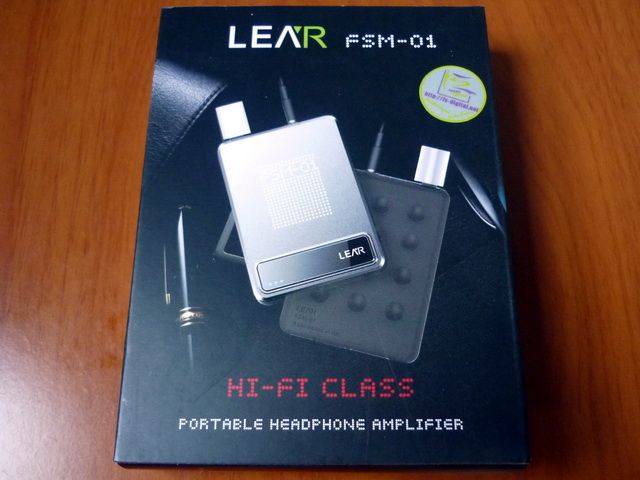
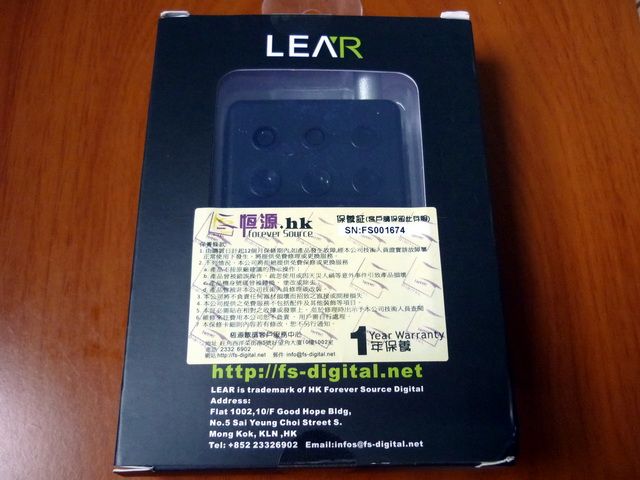
SPEC
Frequency response: 1Hz~100 kHz
Output: 130mW @16ohm ; 50mW @ 300ohm (INT BAT)
190mW @ 16 ohms; 75mW@300ohm (DC5.5V EXT)
Headphone Impedance Range: 16ohm ~ 300ohm
SNR: ≧95dB
Distortion: 0.0004%
Operation time: 25hrs up
Charging time: about 3hrs (DC 5V, 500mA)
Charging DC: 5V 1000mA (MAX)
EXT power DC3V~5.5V 1000mA (MAX)
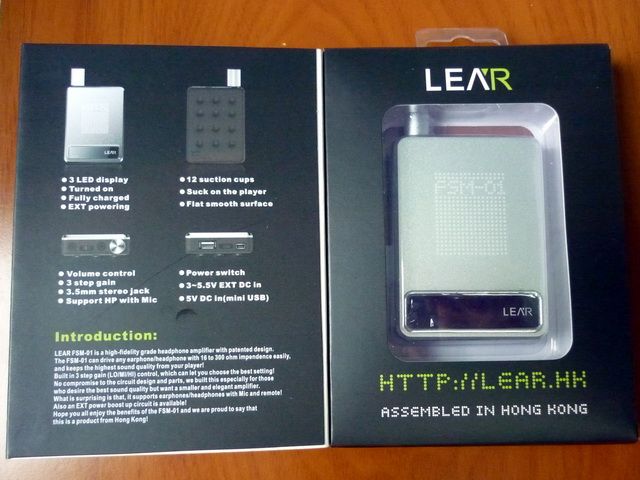
Build Quality and Accessories
Beside some minor points, the overall build quality of FSM-01 is quite good. First, the housing is half aluminum and half plastic. The silvery front panel is CNC’ed out of a single plate of rather thick aluminum with a small piece of black acrylic windows on the bottom for the battery and operation indicator LED. The main body is black plastic that is covered with a silicone rubber case that has 12 small suction cups built-in on the back. Why suction cups? They are for you to attach the amp to the smooth back surface of a DAP. Yes, we are talking mainly about iPhone and iPod here. So does the suction cups work? Well, to a certain extent, yes. It will stick to a clean and smooth surface and stay there for a while if left undisturbed. But if it is dusty then the suction might not be strong enough to hold very firmly, which will make the amp slide down slowly. It is a very novel idea to use suction caps to attach the amp to DAP but it is not foolproof, and you might need other means to secure it in place (i.e. a silicone band). In any case, I think it would also be a good idea to just include an extra rubber case that has no suction caps, just for those who never need them in the first place.
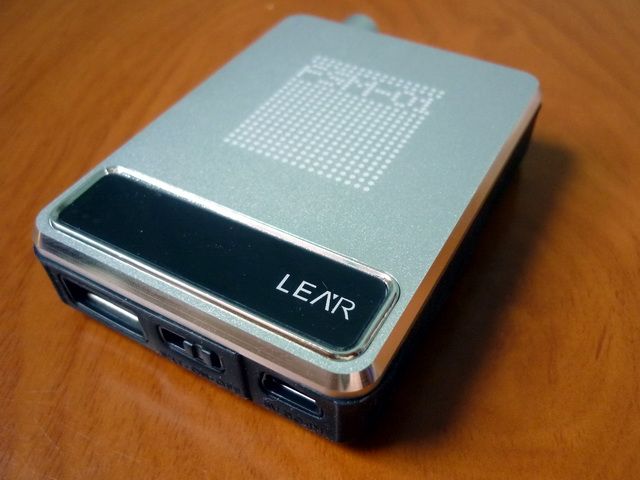
Bottom: (from left) USB EXT power input, ON/OFF/EXT switch, Mini-USB for recharging.
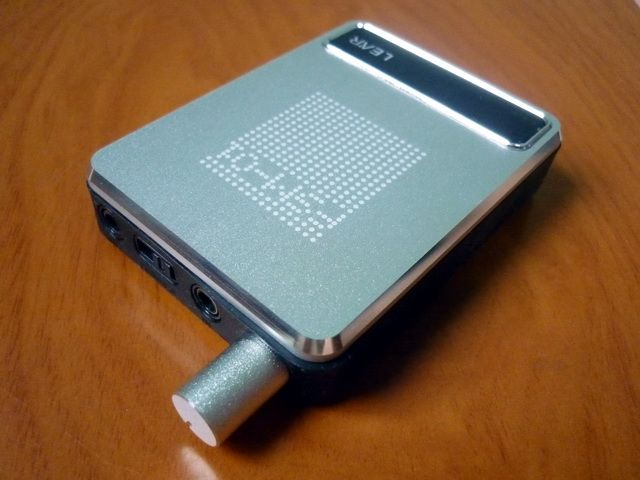
Top: (from left) 3.5mm TRRS out, three stages gain switch, 3.5mm TRRS input.
On the top of the amp, there are the 3.5mm input and output socket, the volume pot and the gain switch – all feature unique design of their own. First, both the 3.5mm sockets are designed for TRRS plug and supposedly can be used with headphone that supports mic and remote (again, we are talking mostly iPhone compatible stuff here). Unfortunately you will need either a TRRS to TRRS interconnecting cable or mic+remote supported LOD to get it to work. I believe FS-Digital is planning to release some compatible cable but so far they are not ready yet. Second is the volume pot, which is actually click wheel based pot. That means instead of one smooth motion when you are turning the pot, you will feel a ‘click’ on each slight turn. I have seen click pot used on larger desktop amp before but never a small amp like FSM-01. Third is the gain switch. It has three stage – Low, Mid, and High. Supposedly the low setting is mainly for headphone with 32ohm impedance or under, the mid setting is mainly for beyond 32 ohm up to 100+ ohm while the high gain is reserved for the highest impedance headphone up to 300 ohm. It all seems well except it is not quite the same in practice. If RMAA and multimeter are of any indication, I think the Low and Mid gain settings are actual gain reduction and only the High gain is an actual gain. All and all, I think FS-Digital designed the FSM-01 using a line-level source (i.e. iPhone’s line-out) and thus results in a rather strange gain configuration. Now this is not to say it is all bad as I can see why they have chosen to do it this way. For most amps that has a fixed gain, it is hard to compensate for both highly efficient IEM and not-quite-efficient full sized headphone – you either have too much of a gain or you might end up with not enough. But working between IEM and full sized creates problem of its own. The lower the impedance , the more current the headphone will draw (but voltage / amplitude is not a problem); with higher impedance, the opposite happens as more voltage / amplitude is needed (while current draw is getting smaller). Thus an amp that works both ways needs to behave a little differently –as a current source in low impedance and as a voltage source in high impedance. If we were to put it that way, then the gain switch design makes some sense as low impedance IEM really doesn’t need voltage gain, especially when the input signal is already line-level. There are only two problems: 1) the high gain has noticeably more dynamic and transparency (though not a lot) and 2) the amp doesn’t have enough gain for weak source (i.e. small headphone-out signal). While I think it is yet another novel idea for FS-Digital to try to do-it-all, the end result feels more like compensation than solution.
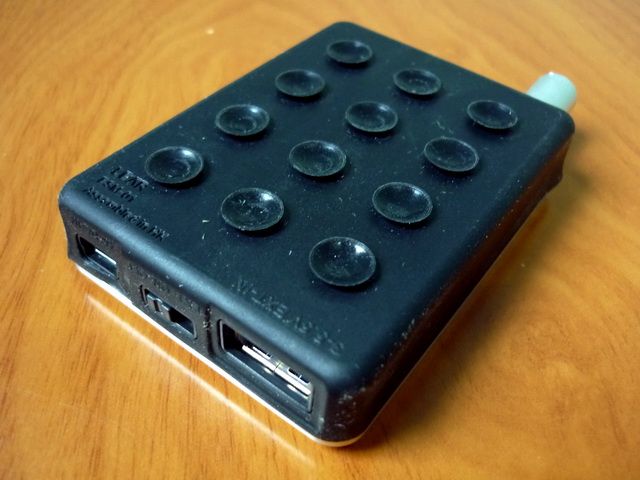
Suction cups on the back

Sticking onto a Hifiman HM801 using the suction cups
On the bottom of the amp, there is a full sized USB female socket (type A), a mini-USB socket and the power switch. The mini-USB socket is for charging; the full sized USB female socket is however for external power source (i.e. USB wall adapter or Li-ion battery pack with USB output) up to 5.5V. The power switch can be set to use either the internal battery or powered by the external power (which will not charge the internal battery). The idea is that the higher power from the external power source can increase the performance of the amp. In practice, I don’t really notice a lot of difference between the internal battery and an external power (which is a Xpal 1000mAh Li-ion pack with 5V USB output). One thing I do notice is the amp is quite sensitive to the cleanness of the external power (this include the mini USB as well). Using my PC USB port or USB wall adapter as external power and the background noise / ripples becomes very apparent. The external power supply via a type-A USB socket is yet another novel idea, but not quite practical. The real usefulness is perhaps to increase battery life when traveling or using a battery pack as a pure / clean desktop power source. It would be great to see FS-Digital bundles the amp with a high quality USB adapter, but I can imagine it would have to be a linear power adapter which will be far too expensive and big in size.
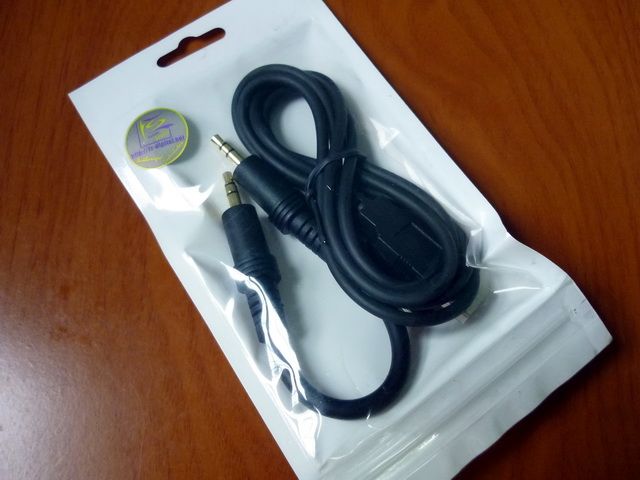
Accessories wise, there are a rather good quality 3.5mm interconnecting cable and an USB cable. Though I don’t receive any silicone band with my FSM-01 package, I do believe I have seen other FSM-01 user posting about it. You might want to confirm with the seller if it is included or not as all accessories come in a different packaging outside of the FSM-01’s box.
Battery Life
FSM-01’s battery is listed at 25 hours or more. I didn’t have the time to drain it fully, but I can confirm it will run over 10 hours easily.
Hissing and EMI
Hissing is not a problem for Low and Mid gain, but it becomes quite noticeable on low impedance IEM on high gain. The FSM-01 I am using now is the standard version which is meant to drive both high impedance headphone as well as low impedance IEM. There is however another version of FSM-01 called the ELN, stands for Extra Low Noise, and it is designed purely for low impedance headphone. I have never heard it myself but it is said to have lower output and thus lower / no hissing. For high gain on standard FSM-01, it is better to stick to headphone or IEM with high impedance and relatively low sensitivity.
EMI (electromagnetic interference) is actually rather bad on FSM-01. While I have said it before that FSM-01 is designed to be used with DAP like iPhone or iPod, it also picked up EMI easily when it is near a cellphone. In fact, I won’t even recommend placing FSM-01 near a cellphone or any EMI source. If you want to use an iPhone as source, you will be better off switch it to airplane mode and use it like an iPod touch.
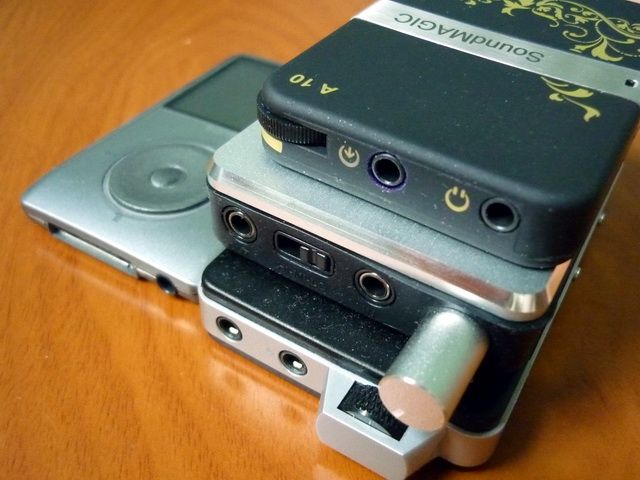
Size comparison: Sansa Fuze (left), SoundMAGIC A10 (top), FSM-01 (middle) and FiiO E11 (bottom).
Sound Quality
What would I describe the sound of FSM-01? It is clean, transparent, minimum coloration that can sound slightly lean and cold as it doesn’t add any warm or richness to the sound. It is actually a bit like the mix of iBasso’s T3D and D-zero - it has the brightness and open soundstage of the D-zero but not the slight hollowness in the mid; the detail and layer of T3D yet better transparent, especially in the background. In fact, the background sinks so deep, I will describe it as being pitch black. It is something I usually only hear in more expensive portable amps that are known for being transparent, like 3MOVE in high current mode. Even T3D, which I always thought to be one of the most transparent commercial amps under $150, couldn’t sound quite as transparent and black as FSM-01.
Knowing a lot of people are looking into amp as an added layer of spice into the music, I won’t say FSM-01 is for everyone. Personally, I always have a preference toward amp that is more transparent than it is rich or warm. This is not to say really warm amp like iBasso T4 or SoundMAGIC A10 won’t sound good when the synergy is right, or the rich CmoyBB or PA2V2 doesn’t sound particular great with the lean ER4S. But sound signature doesn’t equal to performance. When it comes to simple and pure amplification, getting the signal from the source to the headphone without too much additive is really the basic of basic and often what I’ll pay most attention to. Once the fundamental is right, any addition can be a plus – but not the other way around.
Anyway, what will be good pairing with FSM-01 synergy wise? I’ll say anything there isn’t already bright or lean on its own. Some of the best pairing I have with FSM-01 includes PK1, RE262 and NineWave Studio Pro. In fact, RE262 really shines with FSM-01. So will a bright or lean sounding IEM sound bad on FSM-01? No, not sounds bad – just going to be as bright and as lean as it can be. Synergy wise, I won’t say that is the best choice for pairing unless that’s exactly what you are looking for (ER4S does sound really good by the way, just not richer / lusher). With FSM-01, headphone tends to be more revealing of oneself, so don’t expect much flavoring from the amp.
For those who are interested in RMAA test, I did run it over RMAA several times (against FiiO E7 and iBasso D-zero on a 16 ohm load) and found nothing odd in the result. I don't want to post the result here as RMAA can be misleading if read wrongly, plus my soudncard is only good enough to show bad result and not good enough to distinguish between decent and good amp. The only thing worth noting is the increased noise in high gain, which is roughtly double of the low / mid gain but still well under 1% (0.3% -> 0.6%). But given the obvious hissing on high gain, it is nothing surprising. I did a simple test on output impedance and roughly estimate it to under 1 ohm. I can't be 100% sure in the result but I think it should be a good enough approximation.

Verdict
FSM-01 is a peculiar amp for sure. On one hand, it has some really unusual features that are quite innovative; on the other hand, none of these features really work out in 100%. It is a highly transparent amp (which I love) and the best sounding sub$150 amp I have heard (which I place it just under 3MOVE in overall ranking and above all my other sub $150 amps, including T3D, E11, cmoyBB, D-zero, etc), but I also understand a transparent amp is often not the most popular choice. While it has its downsides, FSM-01 still has SQ that outperforms similarly priced amps like the T3D. But as much as I am impressed by FSM-01, I’ll only recommend it to those of you who understand exactly what kind of portable amp you are looking at - which can be quite rewarding if you do.





